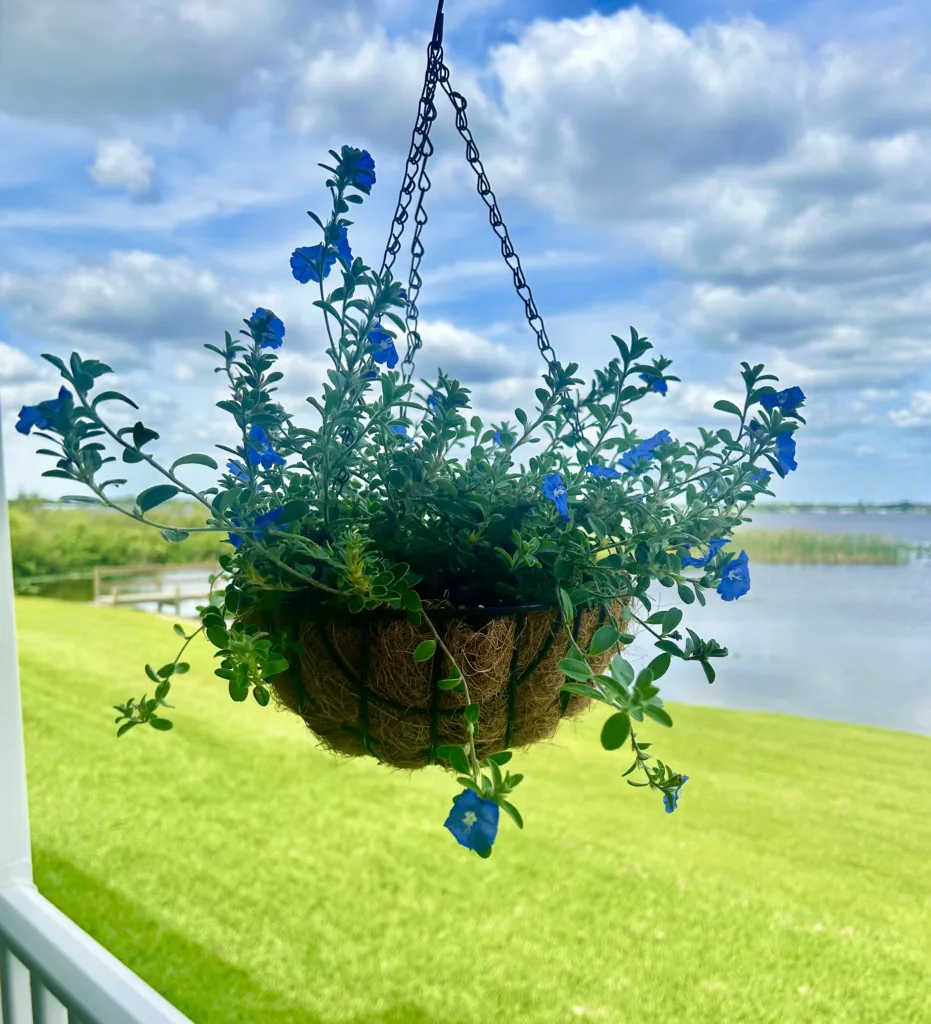
Blue Daze Evolvulus, scientifically known as Evolvulus glomeratus, is a charming perennial plant cherished for its striking blue flowers and lush green foliage. Native to tropical and subtropical regions, this low-growing plant is perfect for garden borders, hanging baskets, and container gardening. In this blog post, we’ll explore everything you need to know about how to grow Blue Daze Evolvulus, including pot type, soil, light, water, fertilizer, and propagation methods.
Pot Type
When growing Blue Daze Evolvulus in containers, choosing the right pot is essential for healthy growth. Here are some tips:
- Material: Terracotta or ceramic pots are ideal as they allow for better airflow and moisture regulation. Plastic pots can work but ensure they have adequate drainage holes. My choice is the coco lined wire hanging baskets.
- Size: Select a pot that is at least 10-12 inches in diameter. This provides enough space for the roots to grow and prevents the plant from becoming root-bound.
- Drainage: Ensure the pot has good drainage to prevent waterlogging, which can lead to root rot.
Soil
Blue Daze Evolvulus thrives in well-draining soil. Here’s how to create the ideal soil mix:
- Composition: A mix of sandy loam soil with organic matter like compost or peat moss works well. This ensures good drainage while providing necessary nutrients.
- pH Level: The soil should be slightly acidic to neutral, with a pH range of 6.0 to 7.5.
Light
Blue Daze Evolvulus loves the sun. Adequate lighting is crucial for vibrant blooms and healthy foliage:
- Exposure: Full sun is ideal, meaning at least 6-8 hours of direct sunlight daily. In hotter climates, some afternoon shade can prevent the leaves from scorching.
- Indoor Growth: If growing indoors, place the plant near a south-facing window to ensure it receives sufficient light.
Water
Proper watering is key to keeping your Blue Daze Evolvulus healthy:
- Frequency: Water the plant regularly, ensuring the soil stays consistently moist but not waterlogged. During the growing season (spring and summer), this might mean watering every 2-3 days, depending on the weather.
- Method: Water at the base of the plant to avoid wetting the foliage, which can lead to fungal diseases. Ensure excess water drains out to prevent root rot.
Fertilizer
Fertilizing Blue Daze Evolvulus helps promote lush growth and abundant blooms:
- Type: Use a balanced, water-soluble fertilizer with equal parts nitrogen, phosphorus, and potassium (e.g., 10-10-10).
- Frequency: Feed the plant every 4-6 weeks during the growing season. Reduce feeding in the fall and winter when the plant’s growth slows down.
- Application: Follow the manufacturer’s instructions for dilution and application rates. Avoid over-fertilizing, which can harm the plant.
Propagation
Propagating Blue Daze Evolvulus is relatively easy and can be done through cuttings:
- Timing: Take cuttings in spring or early summer when the plant is actively growing.
- Cuttings: Choose healthy stems and cut 4-6 inch sections just below a node. Remove the lower leaves, leaving a few at the top.
- Rooting Medium: Dip stem in rooting hormone and place the cuttings in a well-draining potting mix or a mix of sand and peat moss. Keep the soil moist and cover the pot with a plastic bag to retain humidity.
- Environment: Place the pot in a warm, bright location but out of direct sunlight.
- Transplanting: After a few weeks, the cuttings should develop roots. Once established, transplant them into individual pots or the garden.
Happy Gardening!
Caring for Blue Daze Evolvulus is straightforward, making it an excellent choice for both novice and experienced gardeners. With the right pot, soil, light, water, and fertilizer, this beautiful plant will reward you with its stunning blue blooms and lush foliage.
Please be sure to check out my Gardening Blog Post Page for more tips on all types of gardening. Including Seed Starting, Orchids, Water Gardening, Coldframe Gardening, Indoor Bulb Gardening, Hydroponics, Container Gardening, Mums, Herbs, African Violets, planting Bulbs, Flower Gardening, Vegetable and Fruit Gardening, Indoor Houseplants of all kinds, Cactus, Succulents, Hanging plants, Deer resistant plants and even Bird, Bee, Butterfly and Hummingbird Gardens!
